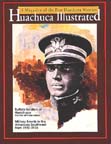 Huachuca
Illustrated, vol 1, 1993:
Huachuca
Illustrated, vol 1, 1993: Huachuca
Illustrated, vol 1, 1993:
Huachuca
Illustrated, vol 1, 1993:
chuca Illustrat
chuca Illustrat
Military Intelligence in the American Southwest:
Border Spy Network
huca -----------
During the Punitive Expedition into Mexico in 1916 led by General John J. Pershing, human intelligence (HUMINT) and signal intelligence (SIGINT) took on new proportions. Although an embryo intelligence staff had been organized in 1903 as part of the Army's General Staff, in the field intelligence was often relegated to the Engineer as an extra duty.
General Pershing's "Report of the Punitive Expedition, July 1916 -February 1917" summed up the work of the "'Information Department)":
The Information Department was conducted by the Assistant Chief of Staff, Capt. W. O. Reed, 6th Cavalry, assisted by Capt. Nicholas W. Campanole, 6th Infantry. The ... department had to interest itself in the movements of Villa and his forces, and likewise the movements, activity and intentions of the Carranzistas. There were a number of Japanese who offered themselves for service in this department and some were used but with very mediocre results, as they were not regarded as altogether trustworthy. A few reliable Mexicans were employed in the Secret Service with fairly good results.
It was early observed that the Mexican authorities had no code in general use but that each commander had his own local code for use with higher authority or even subordinates. This department took up the study of code messages and soon was able to decipher any code used in Northern Mexico. Thereafter, by tapping the various telegraph and telephone wires and picking up wireless messages we were able to get practically all the information passing between the various leaders in Mexico.
On entering Mexico the question of guides and scouts was a serious one as there were but few reliable maps available. The scarcity of water at that season of the year made it necessary to depend upon guides familiar with the country. A number of cattlemen were obtained as guides and scouts, and while most of them rendered very valuable and efficient service, many others were found to be worthless. Lists of those known to be efficient, showing the country most familiar to them , has been compiled by these headquarters and copies furnished the district headquarters at El Paso for future reference.(81)

A Signal Corps Radio Tractor in the field, around
1918. U.S. Army photo.
In the report of the "U.S. Army Southern Department" the Engineer complains, "In addition to the activities mentioned elsewhere in this report [i.e., reconnaissance, surveying, mapping, laying out camps, etc.] and to miscellaneous duties devolving upon this office, a considerable amount of intelligence work was performed. Prior to his relief from that additional duty, this work attained proportions to require about one-half the time of the Department Engineer ......
General Pershing realized that good intelligence was necessary if he was to track down the bandit/revolutionary Pancho Villa. Pershing appointed an intelligence officer to his staff and started an "Information Department." Later, when five separate districts were established in the Mexican theater of operations, he instructed the district commanders "to organize [their] own agents and establish as far as possible [their] own service of information."

General Pershing in his staff car. In the front seat,
is his aide, Lt. J. Lawton Collins. U.S. Army photo.
The records of the Punitive Expedition refer to "Agent A," "G," and "J," and "Messenger O." There were also references to three "scouts" named Suzuki, Sato and Dyo. These men were apparently part of a spy network that reported from Mexico. Two of Pershing's agents had penetrated Villa's camp in September 1916 and talked to Pancho himself. They noted that he was fully recovered from his leg wound and able to mount and dismount with no difficulty. They placed the villista strength at 800. (82)
The lessons Pershing learned about the value of military intelligence during the 1916 Punitive Expedition caused him to place great reliance upon this tool during World War I when he commanded the American Expeditionary Force and organized a G2 section along French and British examples.
Footnotes:
81. Report of the Punitive Expedition.
82. Clendenen, Clarence C., Blood on the Border, Macmillan Publishing
Co., NY, 1969, 332-3.